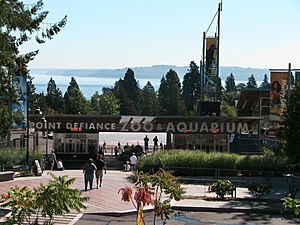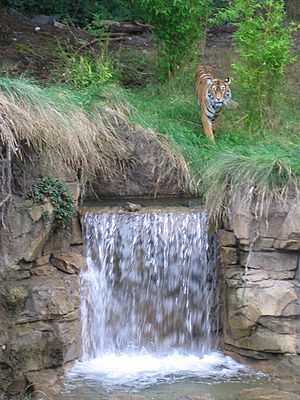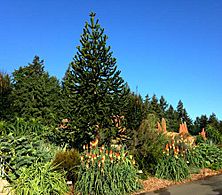- This page was last modified on 17 October 2025, at 10:18. Suggest an edit.
Point Defiance Zoo & Aquarium facts for kids

The entrance to PDZA
|
|
| Date opened | 1905 |
|---|---|
| Location | Tacoma, Washington, US |
| Land area | 27 acres (11 ha) |
| Coordinates | 47°18′17″N 122°31′15″W / 47.3048°N 122.5207°W |
| Annual visitors | 732,000 (2015) |
| Memberships | AZA |
| Major exhibits | Kid's Zone, Arctic Tundra, Rocky Shores, Asian Forest Sanctuary, Red Wolf Woods, South Pacific Aquarium, Pacific Seas Aquarium |
The Point Defiance Zoo & Aquarium (PDZA) is a special place in Tacoma, Washington, USA. It's the only spot in the Pacific Northwest that has both a zoo and an aquarium! Metro Parks Tacoma owns and runs this amazing park.
Located on 29 acres (12 ha) inside Tacoma's Point Defiance Park, the zoo and aquarium are home to over 9,000 animals. These animals represent 367 different species. The zoo first opened in 1905. The aquarium started in 1935 near Commencement Bay and moved to the zoo grounds in 1963. Both are officially approved by the Association of Zoos and Aquariums, which means they meet high standards for animal care. PDZA is a very popular place to visit in Pierce County, Washington, welcoming over 600,000 people every year.
History of the Zoo and Aquarium
The Point Defiance Zoo first opened its doors in 1905. It moved closer to its current spot in 1914. The Point Defiance Park Aquarium began as a separate place on the waterfront in 1936.
Building New Homes for Animals
By the late 1940s, some of the zoo's buildings needed repairs. An old animal house, which was 36 years old, was taken down. A new one was built with strong sandstone walls and thick viewing windows. This new building housed large cats and white-cheeked gibbons.
In the 1960s, the Point Defiance Park Aquarium became part of the zoo. A new aquarium, called the North Pacific Aquarium, was built on the zoo grounds in 1963. This aquarium was later replaced by the Pacific Seas Aquarium in 2018.
Helping Endangered Animals
By the end of the 1960s, the zoo started a special program to help red wolves. These wolves were declared an endangered species in 1967, meaning they were at risk of disappearing forever.
In the early 1970s, some of the older animal cages were wearing out again. After people voted to approve $7 million in 1977, the zoo opened the Arctic Tundra area in 1981. The Rocky Shores area followed in 1982. With more funding in 1986, the South Pacific Aquarium was built and opened in 1989.
Zoo Improvements and New Exhibits
The zoo faced some money problems in the 1990s. However, new funding in 1999 helped make many improvements. With over $35 million, the zoo built a new animal hospital and an outdoor animal theater. They also created the Asian Forest Sanctuary and much of the Kids' Zone children's zoo. The main entrance was also updated.
In 2008, a new part of Kids' Zone called Animal Avenue opened. The red wolf exhibit was updated and reopened in 2010. A new exhibit for clouded leopards, called Cats of the Canopy, opened on August 27, 2011.
Beluga Whales at the Zoo
The zoo used to be home to beluga whales. In 1997, a beluga named Mauyak was sent to Shedd Aquarium for a breeding program. She had two calves there.
In March 2009, one of the belugas at Point Defiance, Qannik, passed away from a blood infection. Beethoven, Qannik's tankmate, moved to SeaWorld, San Antonio, on June 5, 2009. His brother, Turner, had passed away earlier in 2006. The zoo does not currently have beluga whales. The Rocky Shores exhibit now houses harbor seals and California sea lions where the belugas once swam.
Zoolights Holiday Event
Since 1988, the zoo has hosted a popular holiday event called Zoolights. This event usually takes place between November and January. Visitors can walk through the park at night and see over 800,000 lights. The lights are shaped like holiday themes and zoo animals.
Explore the Exhibits
The zoo's exhibits are designed to show different ecosystems from around the Pacific Ocean. These include areas like Southeast Asia, the Pacific Northwest, the tundra, and various aquatic environments.
Asian Forest Sanctuary
This large 5-acre (2.0 ha) exhibit opened on July 1, 2004. It looks like the forests of Southeast Asia, with a waterfall, streams, and plants like bamboo. The exhibit is designed so that different animals can use different parts of it each day. The Asian Forest Sanctuary is home to Sumatran tigers, northern white-cheeked gibbons, and siamangs. An Asian elephant named Suki lived here until August 2024.
An expansion called Cats of the Canopy opened on August 27, 2011. This area focuses on the clouded leopard. Visitors can watch these cats through a wide glass window. The tall, twenty-foot enclosure allows the cats to climb high in the trees.
Kazu, an endangered male Malayan tapir, was born here on July 12, 2019.
Rocky Shores
Completed in 1982, this exhibit looks like the shoreline of Cape Flattery, Washington. It is home to harbor seals, California sea lions, sea otters, horned puffins, common murres, and tufted puffins. Each animal has its own pool. In the middle of the exhibit, there is a building where you can watch the animals swim underwater. This exhibit also houses Pacific walruses Balzik and Lakina, who were born in 2016.
Arctic Tundra
This exhibit opened in 1981 and forms a semicircle at one end of the zoo. Muskoxen and reindeer live in a large meadow on the outside of the pathway. Polar bears and Arctic foxes live on the inside. The polar bears have a deep, eleven-foot pool where you can see them swimming both above and underwater.
The Aquariums
The zoo has two aquariums: the Pacific Seas Aquarium and the South Pacific Aquarium. Each one features animals from different parts of the Pacific Ocean.
Pacific Seas Aquarium
The Pacific Seas Aquarium opened in September 2018, replacing the older North Pacific Aquarium. Its Baja Bay tank is home to scalloped hammerheads, spotted eagle rays, and green sea turtles. Other cool parts of this exhibit include a 10,000-US-gallon (38,000 L) Puget Sound tank and a kelp forest tank. You can also find a cold water invertebrate touch tank, jellyfish displays, a schooling fish exhibit, a giant Pacific octopus, and Japanese spider crabs. This aquarium was built using modern, eco-friendly technology, including a system to collect rainwater.
South Pacific Aquarium
The South Pacific Aquarium, built in 1989, shows off tropical Pacific environments. In 2024, it reopened as the Tropical Reef Aquarium. It has beautiful coral reef tanks, a lagoon exhibit, a blue hole exhibit, and a touch tank. The lagoon has small fish and eels. The large 250,000-US-gallon (950,000 L) Outer Reef tank is home to nurse sharks, blacktip reef sharks, grey reef sharks, whitetip reef sharks, zebra sharks, and a tasselled wobbegong. In the touch tank, you can feel stingrays, epaulette sharks, and whitespotted bamboo sharks. As of 2024, visitors can even take part in shark dives in the Outer Reef Habitat!
Red Wolf Woods
This habitat was rebuilt in 2009 and reopened in the summer of 2010. It has two separate meadows with a rocky creek and a hollow log. The conservation center here looks like an old farm building.
Kids' Zone
The Kids' Zone is a fun area with animals like Nigerian dwarf goats and Parma Wallabies. There are also colorful play structures and a petting zoo where you can feed goats.
Animal Avenue, an expansion of the children's zoo, lets you meet various species. These include meerkats, ring-tailed lemurs, and black and white ruffed lemurs. The Kids' Zone also includes "Magical Movement" and "Contact Junction" sections.
Botanical Garden
The Point Defiance Zoo Botanical Garden is a certified botanical garden. It has a collection of over 50 types of bamboo. You can also see huge meadows filled with Lobelia tupa, and sweet-smelling perennials that attract pollinators. Many different trees and shrubs are planted all around the grounds. The garden features plants from the Baja Peninsula, the Southern Hemisphere, and Alaskan landscapes. There are also plants from the Southeastern United States, wildflowers, a desert garden, and plants from the Asian Forest Sanctuary and the Native Northwest. The landscaping helps show how animals, plants, and people need to live together. The zoo has hundreds of plant varieties, from decorative ones to those that serve a purpose. The zoo's Horticulturist offers monthly tours of the botanical garden.
Other Exhibits to Explore
Other exhibits include an artificial tide pool and a habitat for Magellanic penguins. There is also a seasonal exhibit for budgies. You might even see Indian Peafowl roaming freely throughout the zoo grounds! The zoo used to offer camel rides, but when they built the Nature Play Garden, the Dromedary Camels returned to their owners at a local farm.
Conservation Efforts
One important part of the zoo's conservation work is helping the red wolf. The zoo began collecting wild red wolves in 1969. They successfully bred them for the first time in 1977. By 1980, the U.S. Fish and Wildlife Service had moved the last fourteen wolves from the wild to safety. In 1984, the zoo received approval to start a Species Survival Plan. By 1987, there were enough red wolves in captivity to release some back into the wild. These reintroduced wolves continue to live and have pups in the wild. By 2002, there were 175 red wolves in captivity and about 100 in the wild. One of the biggest challenges for the wild population is when coyotes and wolves breed together.
The zoo also works to protect other endangered animals. In 2021, there was an effort to breed endangered Sumatran tigers. This was an important step to help save the species, as there are only about four hundred Sumatran tigers left in the wild.



